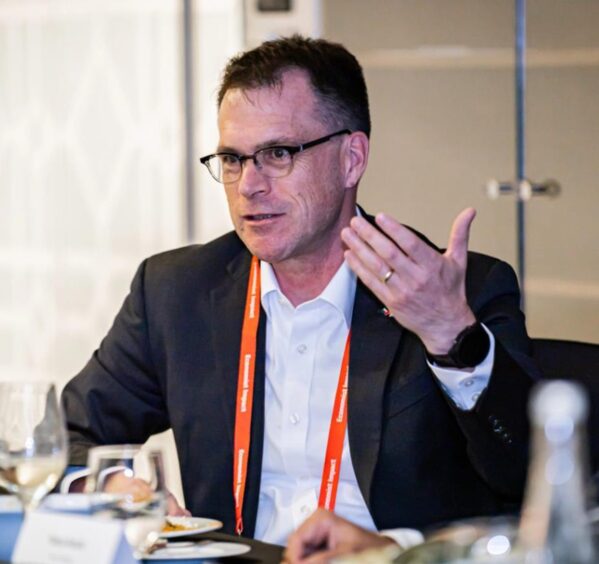Carbon capture and storage (CCS) is starting to take shape, as industry takes steps to decarbonise and confidence growing from customers.
At one end of the scale, ever grander projects are being designed to secure a place for large polluting sites. However, and just as importantly, progress is also being made on smaller scale projects with CCS aiming to play a part in tackling the broader problem of emissions, beyond energy alone.
“Industries like power have made the most progress, while interest is emerging in sectors such as cement,” Technip Energies SVP of decarbonisation solutions Christophe Malaurie told Energy Voice.
Fitting the technology
Technology to tackle emissions at power plants is well advanced, he continued. The one technology that works at scale is amine based. Technip Energies uses that in collaboration with Shell, Cansolv, which is adapted to capturing emissions from power.”
This amine technology requires steam, which there is in abundance in power plants. “For capturing emissions from cement, for instance, the current technology can fit, but it may need some tweaks,” Malaurie said.
Technip Energies is assessing other technologies, such as membrane and cryogenic, for alternative CCS techniques. “We’re also scouting what may be the best technology for direct air capture (DAC). For DAC, the cost is still high, but with improvements in technology it should become more economic,” he continued.
Smiths Group chief sustainability officer John Ostergren told Energy Voice that decarbonising industry was a “certainty” and that cement is the best example. The cement industry is a major emitter.
“If we want to continue using cement as a material, we will need carbon capture and storage. There’s a requirement for a broad decarbonisation of industry,” Ostergren said.
Technip Energies was recently chosen by Uniper to provide a work package for a CCGT power plant at the Isle of Grain, in southeast England. The CCS project award could involve the capture of more than 2 million tonnes per year of CO2.
The contract covers capture, conditioning, liquefaction and temporary storage. The plan involves transportation of the CO2 – by ship or pipeline – to a permanent storage site under the seabed. Technip Energies projected a final investment decision (FID) may come in the mid-2020s.
Existing plant
Speaking before the Uniper project award, Malaurie explained retrofitting a facility was not complex. “The conversation around retrofitting is more around the cost and the economics. It’s cheaper to install during construction, than add on later.”
Efforts to capture emissions from existing facilities are under way around the world. Mitsui & Co. recently signed an agreement with a Japanese power producer, Chugoko Electric Power Co., to study options for exporting carbon to Malaysia.
The aim would be to link up with a proposed storage site offshore Malaysia. Mitsui is working on the Malaysian plan with Petronas and TotalEnergies. Chugoko Electric’s plan has some similarities to that at the Isle of Grain, with plans for liquefaction and transportation.
Mitsui, Petronas and TotalEnergies have been working on a CO2 storage plan off Malaysia since June 2023. They aim to begin injecting CO2 by 2030. The 2023 agreement saw the three partners agree to study a number of sites, both saline aquifers and depleted fields, in the Malay Basin.
Transportation of liquefied CO2 brings challenges, with collaboration required to tackle them. Technip Energies’ Malaurie noting the UK strategy of building industrial clusters, with access to CO2 injection sites.
He cited projects such as Norway’s Northern Lights and the UK’s BP-led CCS project Northern Endurance Partnership. The US is also making progress in this regard.
“For CCUS to work, we need different areas to work in parallel. We need to collect, to transport and to sequestrate. This will need collaboration,” he said. “In collecting CO2, industry and solution providers need to work together to drive down costs, through standardisation and more projects.”
It does seem that interest in CCS, and liquefaction of CO2, is on the rise. KBR, for instance, recently won a front-end engineering and design (FEED) contract from Fidelis New Energy. The plan covers an onshore facility at Denmark’s Port of Aalborg.
Support
Smiths Group’s Ostergren highlighted activity in the US, as driven by Inflation Reduction Act (IRA).
“There’s a rush to transition ideas to projects and infrastructure – to get CO2 flowing in the right direction. In the last 12 months, the opportunity pipeline has more than doubled in the hydrogen and CCS space,” he said. “It’s safe to say we’re in the exponential growth phase – but we have to move at least that fast in order to reach our goals.”
Technip Energies also sees growth potential in the sector. Malaurie predicted that, by 2030, there was demand for around half a billion tonnes per year of CCUS capacity. “That’s around 300 million tonnes in the US and 200 million tones in Europe, with a little in Asia,” he said.
Europe and the US have both seen government support supporting carbon capture projects. There have also been significant commitments from companies around decarbonising, which makes CCUS the only option in many instances.
“We have projects that are potentially reaching FID in 2024. A year ago, it was much less,” Malaurie said. “We are at the phase where customers are ready to take the leap of faith, if the economics are acceptable. Once the first is built, then we can start to replicate and move to standardisation.”
The important step is to build the first, he continued. This would set the stage for future acceleration.
“We’re having conversations with customers who say I want one, but with 12 to come, so let’s partner. It will have to happen if we are going to reach out 2030 goals. We’re climbing the curve where we can see acceleration over the year to come. Once those FIDs come, and the projects show they are economic, we could see a switch very quickly.”
Local content
A number of elections are taking place around the world this year, with the possibility of changing the landscape for CCS.
Ostergren, stating he was an optimist, said the US would be unlikely to reverse the IRA provisions if a new president entered the White House. “It’s more than just turning around, there’s no reason to change course as it’s about energy security. Those interests are aligned.”
All participants agree the aim for the CCS industry is that it must become self sustaining, he continued. “There’s a path to get there and incentives to take us to the tipping point. It’s about as close to uniformity in that confluence of interests.”
Another challenge is that, while country’s governments may back lofty transition goals, building infrastructure inevitably relies on local decisions. Ostergren noted that energy transition plans must be done in a way that brings local communities along, by providing tangible benefits – such as jobs and investment.
There are examples in the wind industry of how this has gone right, he noted, “where local opposition turned to strong support. The limit today is not capital or other incentive elements by the IRA and Infrastructure Law. It is the speed of project approval.”
This desire for local involvement may prove challenging.
“People will need to take a pragmatic approach when it comes to buying local supplies,” Malaurie said. “You can’t have your cake and eat it. There are conversations in the US around ‘buy American’, but obviously that comes at a cost. If buying in America ends up being more than the funding support, it makes the economics questionable. In the US, in particular, there are benefits to buying locally. In Europe, there’s less of an incentive.”
Recommended for you




 © Supplied by Technip Energies
© Supplied by Technip Energies © Supplied by Smiths Group
© Supplied by Smiths Group






